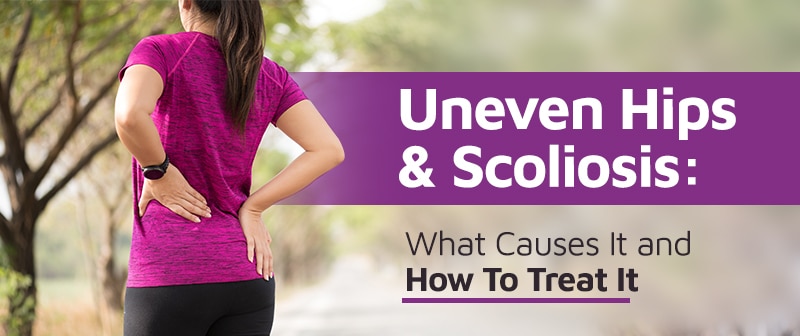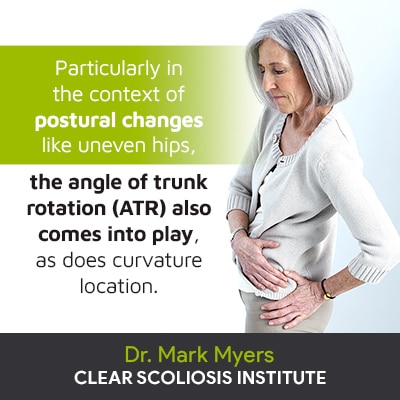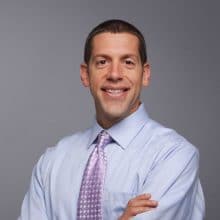
Also referred to as lateral pelvic tilt, uneven hips caused by scoliosis can involve one hip sitting higher than the other, and/or one hip appearing more rounded than the other. As an abnormal spinal curvature develops and progresses, it is exposing the spine to uneven forces that can affect the body’s overall symmetry.
While no two cases are the same, uneven hips are one of the telltale signs of scoliosis. Scoliosis is an abnormal spinal curvature with rotation, and uneven hips are the result of a scoliotic curve pulling on the pelvis. Uneven hips can be addressed through proactive chiropractic-centered treatment.
Before we move on to the specifics of scoliosis-related uneven hips, let’s first talk about the condition generally, for a better understanding of how it introduces adverse forces to the body.
Scoliosis is a highly-prevalent spinal condition with close to seven million people currently living with it in the United States alone, and that number only includes known diagnosed cases; many people live with the condition unaware, especially with mild forms.
A scoliosis diagnosis means an abnormal sideways spinal curvature, with rotation, and a minimum Cobb angle of 10 degrees has developed.
The rotational element is important to understand because although scoliotic curves are sideways in that they bend to the left or right (sagittal plane), a scoliotic spine also twists from front to back, back to front (coronal plane), making it a 3-dimensional condition.
I say the rotation is an important factor because in order for treatment to be effective, it has to impact scoliosis in all dimensions; in fact, addressing scoliosis as a 2-dimensional condition is a shortfall of traditional treatment.
A patient’s Cobb angle is known as the orthopedic gold standard in the assessment, diagnosis, and treatment of scoliosis, and this is because it tells us how far out of alignment a scoliotic spine is, as well as placing a condition on its severity scale of mild, moderate, or severe.
A diagnosis of mild scoliosis would indicate a Cobb angle measurement of between 10 and 20 degrees; a moderate scoliosis diagnosis would include Cobb angle measurements between 20 and 30 degrees. Cobb angles of between 30 and 40 degrees would fall into the moderate or severe classification, with 40+ degrees being classified as severe scoliosis.
Another key characteristic of scoliosis is how much it varies from one person to the next, making it necessary for effective treatment plans to be fully customized to address the specifics of each patient and their condition.
Important patient/condition variables shape a person’s experience of life with the condition and determine whether symptoms, like postural changes, are subtle or overt: patient age, condition type (causation when known), curvature location, and condition severity.

In addition, scoliosis is a progressive spinal condition, meaning it’s in its nature to worsen over time, which is why proactive treatment is so important to prevent increasing symptoms related to increasing condition severity.
So now that we have defined scoliosis as a 3-dimensional progressive spinal condition, and touched on some important condition characteristics, let’s talk specifically about how scoliosis can cause uneven hips.
I mentioned Cobb angle and condition severity earlier because it’s an important factor when it comes to predicting a patient’s likely symptoms and rate of progression.
I say “likely symptoms and rates of progression” because although there are a number of assessment methodologies that can be done, there is no way to predict, with 100-percent accuracy, how a patient’s body will respond to the condition, to treatment, and how fast, or slowly, a condition will progress.
As scoliosis is progressive, it’s virtually guaranteed to progress at some point, and postural changes are highly dependent on condition severity.
As a scoliotic curve increases in size, at varying rates, condition-related symptoms, like uneven hips, tend to also increase and become more noticeable.
The most common visual sign of scoliosis is how it affects the body’s overall symmetry:
As mentioned earlier, the spine is connected to the ribs and pelvis, so when an abnormal spinal curvature develops and progresses, it pulls on these structures, changing their position, often causing a rib arch, and affecting the alignment of the hips.
As mentioned, uneven hips can involve one hip sitting higher than the other, and/or one hip having a more rounded appearance than the other.
In addition, there are some cases where uneven hips are related to an anatomical or functional short leg, known as leg-length discrepancy (LLD); as a CLEAR-certified scoliosis chiropractor, I’m trained in distinguishing between the different types of short-leg appearances.
There are some important differences between anatomical and functional short legs; with anatomical short legs, there is a measurable difference on the X-ray that will not change.
Anatomical short legs can be caused by a fracture in a growth plate, trauma when younger, or in some cases, it’s idiopathic, meaning the causative source is unknown.
Functional changes in a short leg can occur when there is abnormal pressure on part of the nerves at the C1 (1st vertebral body of the cervical spine), or in some cases, it can happen due to a misalignment in the pelvis.
When a functional short leg is corrected, the feet will balance when checked after the adjustment, and there are also noticeable differences on the X-ray taken after the correction, and this is how we can confirm corrective results.
Treatment for a functional short leg usually involves aligning the C1 vertebral body, and sometimes, pelvic adjustments are performed to balance the legs; anatomical short legs will have to be treated with a lift or shoe being built up by a shoe cobbler, depending on the severity of the discrepancy between the two legs.
Uneven hips can caused by scoliosis can also affect the appearance of the legs with one looking longer than the other; it's the overall asymmetrical effect that scoliosis has on the body that can also cause clothes to become ill-fitting and changes to gait, balance, and coordination.
Due to the rotational component of scoliosis, the twisting spine can cause the ribs and/or muscles on one side of the body to protrude more than on the other side; the uneven forces that scoliosis introduces to the body don’t just affect the spine, but also its surrounding muscles that struggle to provide support for an abnormally-curved spine.
As scoliosis is a structural condition that causes the vertebrae (bones of the spine) to tilt and twist unnaturally, this causes the spine to become misaligned, and as the spine is attached to the pelvis, the pelvis can also become unnaturally tilted and misaligned, which is what causes uneven hips.
An aligned spine should appear straight when viewed from the front or back and appear to have a soft ‘S’ shape when viewed from the sides, and an aligned pelvis should be parallel to the shoulders and the ground.
Aligned hips should also not be tilted forwards or backwards, and each hip should be on the same horizontal level, in contrast to one appearing higher than the other.
So now that we understand how the uneven forces that scoliosis introduces to the body can cause uneven hips, plus additional causes, what can be done about it?

While there are no treatment guarantees, different treatment approaches offer different potential outcomes, so patients need to ensure their treatment expectations are aligned with the realities of their chosen treatment approach.
As a CLEAR doctor, my approach is conservative, functional, and chiropractic-centered. I also integrate multiple forms of treatment for the most customized and specific results.
When it comes to correcting uneven hips caused by scoliosis, the key is a proactive treatment that addresses the condition’s 3-dimensional structural nature, so treatment has to, first and foremost, impact the condition on a structural level, which is where chiropractic care comes in.
Through precise condition-specific chiropractic adjustments and specific exercises, I can work towards restoring as much of the spine’s natural curvatures as possible; by achieving a curvature reduction and realigning the spine, the uneven forces are reduced, as is the pull on the pelvis that the misaligned spine causes, and the related misalignment of the pelvis.
Achieving a curvature reduction relieves the adverse pressure that’s causing the pelvis to become unnaturally tilted, and the hips can start the process of settling back into a more natural and even position.
I also rely on physical therapy and scoliosis-specific exercises (SSEs) to work towards increasing core strength so related muscles can optimally support and stabilize the spine.
Working towards increasing related muscle strength also helps by augmenting the alignment results of chiropractic adjustments as the spine can get the support/stabilization it needs from its surrounding musculature.
It is also important to understand, however, that scoliosis is incurable. While it can be managed effectively, with most curves of 30+ degrees, while they can be reduced, they will not be reduced to zero.
Even after a successful curvature reduction, work has to continue to sustain those results; while every case is different, this can involve regular chiropractic care and custom-prescribed home exercises.
Particularly for more severe cases, corrective bracing can also be an effective form of treatment that works on a structural level.
One of the main benefits of a conservative chiropractic-centered treatment approach is that it is proactive, noninvasive, and functional: meaning the overall health and function of the spine is prioritized throughout treatment.
While there is surgery offered under the traditional scoliosis treatment model, it works towards preventing scoliosis progression and isn’t driven by the same goal of correction.
In addition, while all surgeries come with their share of risks, spinal fusion, commonly referred to as scoliosis surgery, comes with some particularly heavy risks and potential side effects, not to mention the fact that when it comes to uneven hips, many patients are disappointed with the surgery’s cosmetic results.
Why Doesn’t Scoliosis Surgery Fix Uneven Hips?
While patients choose to undergo scoliosis surgery for a number of reasons, one of the main motivations is cosmetic, and it’s not uncommon for patients to feel disappointed that spinal fusion hasn’t returned their body to its pre-scoliotic state.
In addition, the end goal of spinal fusion (stopping progression) also can’t be guaranteed.
As mentioned earlier, scoliosis is a highly-variable condition based on a number of important patient/condition factors, and these factors help determine how a patient’s body responds to the condition, and treatment.
There is no way to know beforehand precisely how a patient’s overall posture and symmetry will respond to the procedure.
One way I explain how spinal fusion can’t always return a person’s body to how it looked prior to having scoliosis is that there is a big difference between fusing a spine so it’s held in a corrective position, and actually achieving corrective results.
While a fused spine can be less vulnerable to progression as the most-tilted vertebrae are fused together to eliminate further movement while the spine is held in place with hardware, this affects spinal function and health and is not the same as correcting a spine’s abnormal curvature on a structural level via more natural means.
It also takes time for a body and spine to settle into its new posture and alignment post-surgery, and how surgery affects the hips directly is also determined by the curvature location.
There are three main sections of the spine: cervical (neck), thoracic (middle/upper back), and lumbar (lower back).
When scoliosis develops in the lower back, the adverse forces are concentrated in that area, so it makes sense that an abnormal lumbar curvature is more likely to cause an excessive amount of pelvic tilt and uneven hips as a result.
The more severe condition-related postural changes are, the more challenging it is to restore uneven hips as the pelvic tilt is more extreme when the surgery is performed.
The bottom line, when it comes to spinal fusion and uneven hips, is that while scoliosis surgery does have potential to straighten a crooked spine by holding it in place, it can’t always restore the body asymmetries caused by the condition, including uneven hips.
When scoliosis develops, it exposes the body and spine to adverse forces and tension, and this affects the back, as well as related areas such as the pelvis and hips.
When an abnormal spinal curvature is pulling on the ribs and pelvis, it can cause the development of a rib arch and an unnaturally-tilted pelvis, which then causes the hips to become uneven.
When it comes to treatment options for addressing uneven hips, it’s key to choose a treatment approach that is proactive, customized, and functional.
Here at the CLEAR Scoliosis Institute, we respond to a diagnosis by starting proactive treatment as soon as possible; this is not only important because of the condition’s progressive nature and increasing symptoms, but also because it’s less complex to treat a scoliotic curve while it’s smaller and before the body has had ample time to adjust to its presence.

CLEAR provides a unique and innovative way of understanding scoliosis. Sign up to receive facts and information you won’t find anywhere else.

Is there any way I can benefit from all of your research and experience if I do not live near your area?
i am 77 have been active but symptoms getting worse. Have had local PT - areas of pain and spasm migrate one area to another over time.
Hello, Sandra,
As part of our CLEAR Scoliosis Institute treatment protocols, our Doctors prescribe customized home spinal weighting and scoliosis specific exercises. These are customized to every person's spine, so once care is finished, you would continue with at-home therapies, therefore not requiring constant in-office care. I suggest contacting the nearest CLEAR Scoliosis Center to determine if you would be a candidate for care and how much care might be required versus how much at home therapies could be done. To find the nearest clinic, please visit our website under Find a Doctor. Best of luck.